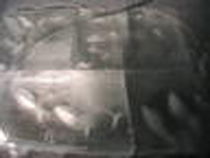

“Spring,” detail of the fish negatively carved into the pond/base of the sculpture.
Photo: Rhonda Konicki for
Ice Alaska
Before sculpting, Qifeng An must first see the ice with which he will be working. You don’t get to choose the piece you want. It is assigned to you. After assessing the ice, he starts drawing the design onto the ice. This is followed by rough cutting with a chainsaw. On “Love” he used the chainsaw to cut into the middle of the ice block. He had made a model at home, but didn’t bring it along. He continues to refine the shape with a small handsaw, a drill and a polisher or sander for the final textures. Ice is very smooth, but with a grain like wood. The Harbin competition requires that the sculptures be from one piece of ice. It starts and ends with the one piece of ice. Cracks in the ice are natural. You try to incorporate them into the design.
Qifeng An particularly likes etching delicate details into the piece. At the base of “Spring” there is a pond with fish etched into it. “Negative (or reverse) carving” is when the artist carves into the back of the ice block, by hollowing out the block. By using this technique, when viewed from the front, the fish appear to be beneath the surface of the pond.
“Spring” was sculpted in 2006, World Ice Art Championships in the abstract category, multi-block competition. These were the artists on that team: Qifeng An, Bing Wen Sun, Jia Fu Guan and Da Quan Zhang.
…to Artists’ Bios